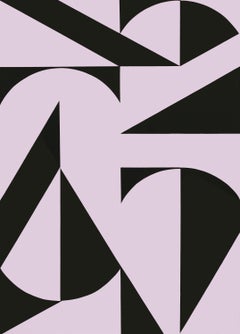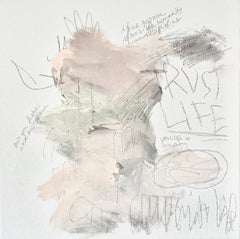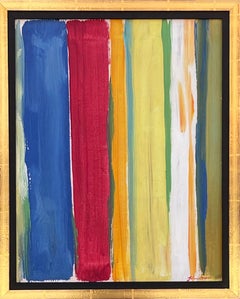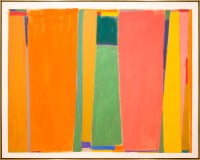John Opper Paintings
American, 1908-1994
John Opper described the 1930s as a "great gestation period" for his art. "I thought the Thirties was a very vital time for American art. . . . With the WPA, you got together whether it was the [Artists'] Union or the [American Artists'] Congress or whether it was a bar. . . and you talked about art, and you heard about important artists, and you began to live art." But Opper also remembered the thirties as a period of breakdown in the vitality of American art; "we became aware that a great deal was missing."
Academically trained like many of his contemporaries, Opper came to New York in 1934, two years after his graduation from Case Western Reserve University in Cleveland, Ohio. As a youth, he had taken Saturday art classes at the Cleveland Museum of Art and later studied at the Cleveland School of Art and the School of the Art Institute of Chicago. When he arrived in New York he was a well-trained painter, adept at rendering still lifes and particularly landscapes depicting the American scene. A reviewer of his 1937 exhibition at the Artists' Gallery in New York, for example, wrote about Opper's "colloquial flavor … spontaneity and an imaginative use of color which conveys just the feeling" that the subjects—East River tugboats, old garages, and scenes around Manhattan— suggested.
By 1937 Opper had become familiar with modernism, though he was not yet converted to the cause. Indeed, his 1937 show was made up of the still popular regionalist paintings. Earlier, in 1935 and 1936, he studied with Hans Hofmann and began to think in terms of forces and tensions within the picture plane. He met Wilfrid Zogbaum, Giorgio Cavallon, Byron Browne, Rosalind Bengelsdorf, and George McNeil, with whom he shared a studio. He paid frequent visits to Gallatin's Gallery of Living Art. He joined the WPA easel project in 1936 and began to paint in "a kind of transformed cubist style."
When war came, Opper worked for three years with a marine architectural firm making drawings for the pipe systems of PT boats. After the war, he taught at the University of Wyoming and the University of Alabama, and between 1952 and 1957, he was on the faculty at the University of North Carolina. In 1957, he began teaching at New York University, where he remained until his retirement in 1974.(Biography provided by WOLFS)
to
4
3
1
2
1
1
1
3
Overall Height
to
Overall Width
to
4
4
3
1
4
903
649
639
610
4
3
2
2
1
Artist: John Opper
Untitled Mid Century Abstract Oil Painting New York Artist
By John Opper
Located in Beachwood, OH
John Opper (American, 1908 - 1994)
Untitled, 1959
Oil on board
Signed and dated lower right
14.75 in. h x 18 in. w.
20 in. h. x 24.5 in. w., as framed
John Opper described the 1930s...
Category
1950s Abstract John Opper Paintings
Materials
Oil
Untitled
By John Opper
Located in Austin, TX
Oil on canvas. Signed lower right, signed and dated verso.
62.25 x 56.25 in.
64 x 58 in. (framed)
Custom framed in a natural cherry wood floater.
Provenance
Washburn Gallery, New York
Behnke Doherty Gallery, Washington Depot, CT
Born in 1908 in Chicago, John Opper moved with his family to Cleveland, Ohio, in 1916. In high school, he began studying art and attending classes at the Cleveland Museum of Art.
After graduation, he enrolled in the Cleveland School of Art (now Cleveland Institute of Art), only to withdraw after a year and move to Chicago, where he took classes at the Art Institute of Chicago. He eventually returned to Cleveland, enrolling at Western Reserve University (now Case Western Reserve), receiving his bachelor’s degree in 1931. The Depression has taken hold during this period, so Opper found work by teaching metalworking and sketching classes at the Karamu Settlement House, the oldest African American theater in the United States.
In 1933, Opper traveled to Gloucester, Massachusetts, eventually connecting with the artist Hans Hofmann, who was teaching at the school run by Ernest Thurn. Hofmann encouraged Opper to work “in a more modern vein and start finding what it’s all about.” Heeding this advice, Opper relocated to New York, co-founding a mail-order club of American and British prints for dissemination to schools and museums.
By the mid-1930s, he joined the Works Progress Administration (WPA) Easel Division, and also began attending the 57th Street school that Hans Hofmann had established after leaving the Art Students League. Looking back at his time at the school, Opper felt that beyond Hofmann’s teaching, most advantageous was his contact with fellow artists, including Byron Browne, Rosalind Bengelsdorf, and George McNeil. At the time, he also met Giorgio Cavallon and the sculptor Wilfrid Zogbaum.
In 1936, Opper became a founding member of the American Abstract Artists, along with Balcomb and Gertrude Greene. The organization was formed to provide an opportunity for artists to show abstract works at a time when such opportunities were scarce. This led to his first solo show in 1937 at the Artists’ Gallery in New York.
During his summer in Gloucester in 1933, Opper came to know Milton Avery. Painting in Avery’s informal studio in New York City the following winter, he became acquainted with Adolph Gottlieb and Mark Rothko. Opper participated in a couple of shows during the 1930s of the American Artists Congress Against War and Fascism, whose president was Stuart Davis. About the same period, Opper joined the Artists’ Union and served as the business manager of its publication, Art Front.
During World War II, Opper worked for a ship design company creating drawings for piping systems used in PT boats...
Category
1950s Abstract Expressionist John Opper Paintings
Materials
Canvas, Oil
Untitled
By John Opper
Located in Lawrence, NY
Provenance: Martha Jackson Gallery, NY; Anderson Gallery, Buffalo, NY.
In a career that spanned nearly six decades and combined aspects of Abstract Expressionism and Color Field painting, Mr. Opper became known for vibrantly colored paintings in which soft, cloudlike forms, or elongated plinths jostled gently against each other.
By American standards an early convert...
Category
1950s Abstract Expressionist John Opper Paintings
Materials
Oil
Untitled (70/8)
By John Opper
Located in New York, NY
1970
Acrylic on canvas
54 x 54 in. (137.2 x 137.2 cm)
Signed, lower right
Category
1970s Abstract Geometric John Opper Paintings
Materials
Canvas, Acrylic
Related Items
Pressure Drops II
By Michael Conrads
Located in Torino, TO
"PRESSURE DROPS II" is a big work, acrylics and overlapping canvas on canvas, 190x135 cm, realized in 2019 by Michael Conrads with a kind of twin work "PRESSURE DROPS I"
Category
2010s Abstract Geometric John Opper Paintings
Materials
Acrylic, Canvas
'trust life' abstract expressionist, Scandinavian artwork
Located in Lahti, FI
"Trust life
Your life is everything
Your passion serves the humanity
It serves all of us"
'trust life' is a reminder that with resilience your life is about to change for the better, for good. Get ready to receive abundance of health, wealth, love and success in this lifetime, loving the way you live and surrendering to your glorious destiny.
Emmi Granlund...
Category
2010s Abstract Expressionist John Opper Paintings
Materials
Canvas, Oil Pastel, Oil, Acrylic, Pencil, Color Pencil
H 19.69 in W 19.69 in D 0.79 in
'do not give up' abstract expressionist, Scandinavian artwork
Located in Lahti, FI
"Don't you ever give up
Don't you ever lose faith
Believe it's yours
Already and forever
Life gets easy
Beauty of the Earth
Enjoy this journey
Being conscious of the birth"
'do ...
Category
2010s Abstract Expressionist John Opper Paintings
Materials
Canvas, Oil Pastel, Oil, Acrylic, Pencil, Color Pencil
H 19.69 in W 19.69 in D 0.79 in
'no more waiting'
Located in Lahti, FI
"No more waiting
No more waiting
No more
Waiting
There are other realms
Where your dreams have
Already happened
Trust the timing of it all"
'no more waiting' is a tribute to tr...
Category
2010s Abstract Expressionist John Opper Paintings
Materials
Canvas, Oil Pastel, Oil, Acrylic, Pencil, Color Pencil
New Synthesis #34
By Jack Roth
Located in Austin, TX
Acrylic on canvas. Signed, dated, titled, and estate stamped on verso.
50.25 x 31 in.
51.25 x 32 in. (framed)
Custom framed in maple.
Provenance
Estate of Jack Roth
Born in Brockway, Pennsylvania, Jack Roth was at various times a painter, poet, photographer, and mathematician. He enrolled at Pennsylvania State University in 1943 to study chemistry, but like many of his fellow Abstract Expressionists, his matriculation was interrupted World War II, where he served in both the Army and Air Force.
Discharged from the service in 1948, Roth moved to Big Sur, California and married his first wife, Colleen Bleier, with whom he had two daughters. A year later, the young family settled in San Francisco, where Jack enrolled at the California School of Fine Arts. It was here that he studied painting under Mark Rothko, Clyfford Still, Richard Diebenkorn, David Park, and Elmer Bischoff.
The Roth family left the Bay Area to return to Pennsylvania, where Jack completed his Bachelor of Science degree in Chemistry in 1951. In pursuit of his seemingly discordant academic interests, Roth moved yet again, this time to Iowa where he received a Master of Fine Arts at Iowa State University in 1953. Seeking gainful employment, Roth moved to New York, settling in the lower East Side where he began looking for a teaching job and working as a reviewer for Arts Digest magazine.
Now divorced, in 1954 Roth married the artist Rachel Chester whom he had met in Iowa. He continued to paint and work odd jobs, some of which were as a hotel night clerk and an orderly at Beekman Downtown Hospital. That year, he unsuccessfully applied for the Guggenheim Memorial Foundation Fellowship in the field of photography.
However, Roth’s professional prospects greatly improved when his work was selected by James Johnson Sweeney, Director of the Guggenheim Museum of Art for the traveling exhibition Younger American Painters, alongside giants such as William Baziotes, Richard Diebenkorn, Adolph Gottlieb, Philip Guston, Franz Kline, Willem de Kooning, Robert Motherwell, Jackson Pollock, Morris Louis, and others. One of the first major debuts of the Abstract Expressionist movement to be shown at an American museum, the exhibit traveled to the prominent museums across the country. In 1956 he began graduate work in mathematics at New York University.
Opting to dive back into academia, Roth began graduate coursework in mathematics at New York University in 1956. He enrolled at Duke University in 1958, receiving his PhD in mathematics in 1962.
Roth continued to create art throughout the pendency of his graduate studies and in 1963, legendary Museum of Modern Art (MoMA) curators Dorothy Miller and William Lieberman recommended Roth as the new talent graphic artist for Art in America. Concurrently, MoMA purchased several works from Roth for the museum’s permanent collection.
During this period of artistic achievement, Roth continued to teach - first, at the University of South Florida in Tampa, before moving back north to Montclair, New Jersey, where he was hired as the chairman of the Mathematics department at Upsala College. In 1971 he accepted a dual appointment at Ramapo College, teaching both mathematics and advanced painting. After he received tenure and his finances were secure, his artistic production thrived as he received the first Thomases Award for contributions at the school, which came with the use of a large studio space. This allowed him to work with larger canvases and become what he saw as an Abstract Expressionist Color Field painter.
In 1978, the acclaimed gallery Knoedler & Co. in New York began representation of Roth’s work. Other artists represented by the gallery at this time included Alexander Calder, Adolf Gottlieb...
Category
1980s Abstract Geometric John Opper Paintings
Materials
Canvas, Acrylic
Oil on Canvas “Arroyo 14”
By Frank Arnold
Located in Fresno, CA
" Arroyo 14" is 72” x 60”. A rich sienna and ochre figure centered on a textured field of light yellows and beige. Frank Arnold’s paintings exhibit the highest quality materials for ...
Category
2010s Abstract John Opper Paintings
Materials
Canvas, Oil
Tavern, Abstract (1960)
By Chuck Close
Located in Saint Augustine, FL
Artist: Chuck Close
Title: Tavern
Year of Work: 1960
Medium: Oil on Canvas
Signature: Signed & Dated Upper Left
Dimensions: framed 31 x 25 unframed 30 x 24
Provenance: Chuck Close, Marjorie Dalton (Dear friend of Chuck), Private Collection.
Tavern, is truly a rare find, an original oil on canvas, in compelling blues and grays with a touch of gold and orange. This work reveals more imagery and detail the longer one enjoys it. This painting was created during his years studying in Yale Art School, and draws different qualities to each new viewer similar to a Rorschach. Close's work is in the collections of most of the great international museums of contemporary art, including the Centre Georges Pompidou in Paris, the Metropolitan Museum of Art New York City. and the Tate Modern in London.
Artist Bio:
Chuck Close – (1940-2021) an American painter, artist and photographer born in Monroe, Washington. Early childhood illnesses including a neuromuscular condition, nephritis and dyslexia were compounded later in life by a condition known as prosopagnosia (face blindness), which may have inspired him to do portraits. Most of his early, large-format portraits are based on photographs, using photorealism or hyperrealism, of family and friends, often other artists. Close often painted abstract portraits of himself and others, which hang in collections internationally. Even though a catastrophic spinal artery collapse in 1988 left him severely paralyzed, he continued to paint inspired by artists like Jackson Pollock and Willem de Kooning. Close's first solo exhibition, held in 1967 at the University of Massachusetts Art Gallery, Amherst, featured paintings, painted reliefs, and drawings based on photographs of record covers. Being much in the mainstream of pop art, a fragment of Close's portrait of singer-songwriter Paul Simon...
Category
1960s Abstract Expressionist John Opper Paintings
Materials
Oil
Studio 1528
By Frank Arnold
Located in Fresno, CA
"Studio 1528" Oil on Canvas presents a bold visage in blues and white on a mixed field dominated by blues and green tone. Frank Arnold is thought by many to be one of the foremost ab...
Category
2010s Abstract John Opper Paintings
Materials
Canvas, Oil
Garden #8 1/2-C
By Beatrice Mandelman
Located in Austin, TX
Diptych, acrylic on canvas. Signed lower right. Two canvases, joined along vertical stretcher on verso.
40 x 60 in.
41 x 61 in. (framed)
Custom framed in maple.
Provenance
Estate of Beatrice Mandelman
203 Fine Art, Taos, NM
A certificate of authenticity issued by the Mandelman Ribak Collection at the University of New Mexico Foundation will be provided with this work.
Beatrice Mandelman was born on December 31, 1912 in Newark, New Jersey. At age 12, she began taking classes at the Newark School of Fine and Industrial Art, subsequently attending Rutgers University, the Newark School of Fine and Industrial Art, and the Art Students League in New York.
In 1935, Mandelman was employed by the Works Progress Administration (WPA), first as a muralist and then as a printmaker with the Graphic Division of the New York Project. One of the original members of the Silk Screen Unit under Anthony Velonis, she worked until the disbandment of the WPA in 1942. During this period, she was associated with numerous New York School artists including Louis Lozowick, Willem de Kooning, Arshile Gorky, Jackson Pollock, and Stuart Davis.
Mandelman married fellow artist Louis Ribak in 1942, and two years later they traveled to Santa Fe, NM to visit his teacher and mentor, the artist John Sloan. Finding Santa Fe congested, they took the train along the Rio Grande and a stagecoach up to Taos and decided to settle there. An impulsive and inspired move, it was a decision that would effectively remove them from mainstream art involvement, for which Santa Fe had become an important outpost in the west. While Taos was a well-known within the art community, there were no galleries exhibiting modern art. This changed later in the decade, with an influx of new artists arriving from New York and California. Some of these artists would come to be known collectively as the “Taos Moderns...
Category
1990s Abstract Geometric John Opper Paintings
Materials
Canvas, Acrylic
Babel II
Located in West Des Moines, IA
This large-scale, abstract work by Harris is sure to enchant any home or space. Harris's vertical bands of color create movement for the eye and leave an element of something new to ...
Category
2010s Abstract Geometric John Opper Paintings
Materials
Canvas, Paper, Ink, Acrylic
New Move
By Frank Arnold
Located in Fresno, CA
"New Move 8" Oil on Canvas is a mix of blues and greens with chrome yellow accents. Frank Arnold is thought by many to be one of the foremost abstract figurative painters and sculpto...
Category
2010s Abstract John Opper Paintings
Materials
Canvas, Oil
Large 20th Century Abstract Expressionist Oil circa 1975
Located in Frome, Somerset
A very good large 20th century Abstract Expressionist oil circa 1975. Stanley Smith (b. 1923) British.
oil on board 61cmx 122cm.
Gallery frame 65cmx 126c...
Category
1970s Abstract Expressionist John Opper Paintings
Materials
Oil
Free Shipping
H 25.6 in W 49.61 in D 1.97 in
Previously Available Items
Untitled abstract blue, red & yellow oil painting, New York artist
By John Opper
Located in Beachwood, OH
John Opper (American, 1908-1994)
Untitled
Oil on canvas
Signed lower right
20 x 16 inches
22.25 x 18.25 inches, framed
John Opper described the 1930s as a "great gestation period" for his art. "I thought the Thirties was a very vital time for American art. . . . With the WPA, you got together whether it was the [Artists'] Union or the [American Artists'] Congress or whether it was a bar. . . and you talked about art, and you heard about important artists, and you began to live art." But Opper also remembered the thirties as a period of breakdown in the vitality of American art; "we became aware that a great deal was missing."
Academically trained like many of his contemporaries, Opper came to New York in 1934, two years after his graduation from Case Western Reserve University in Cleveland, Ohio. As a youth, he had taken Saturday art classes at the Cleveland Museum of Art and later studied at the Cleveland School of Art and the School of the Art Institute of Chicago. When he arrived in New York he was a well-trained painter, adept at rendering still lifes and particularly landscapes depicting the American scene. A reviewer of his 1937 exhibition at the Artists' Gallery in New York, for example, wrote about Opper's "colloquial flavor … spontaneity and an imaginative use of color which conveys just the feeling" that the subjects—East River tugboats, old garages, and scenes around Manhattan— suggested.
By 1937 Opper had become familiar with modernism, though he was not yet converted to the cause. Indeed, his 1937 show was made up of the still popular regionalist paintings. Earlier, in 1935 and 1936, he studied with Hans Hofmann and began to think in terms of forces and tensions within the picture plane. He met Wilfrid Zogbaum, Giorgio Cavallon, Byron Browne, Rosalind Bengelsdorf, and George McNeil, with whom he shared a studio. He paid frequent visits to Gallatin's Gallery of Living Art. He joined the WPA easel project in 1936 and began to paint in "a kind of transformed cubist style."
When war came, Opper worked for three years with a marine architectural firm making drawings for the pipe systems of PT boats...
Category
Mid-20th Century Color-Field John Opper Paintings
Materials
Oil
Bright Orange Plus
By John Opper
Located in Santa Fe, NM
Category
John Opper Paintings
Materials
Canvas, Acrylic
John Opper paintings for sale on 1stDibs.
Find a wide variety of authentic John Opper paintings available for sale on 1stDibs. You can also browse by medium to find art by John Opper in paint, canvas, fabric and more. Much of the original work by this artist or collective was created during the 20th century and is mostly associated with the abstract style. Not every interior allows for large John Opper paintings, so small editions measuring 46 inches across are available. Customers who are interested in this artist might also find the work of Larry Zox, Agnes Hart, and Joseph Glasco. John Opper paintings prices can differ depending upon medium, time period and other attributes. On 1stDibs, the price for these items starts at $25,000 and tops out at $55,000, while the average work can sell for $40,000.






